Overview:
The QFX5120 Switch includes four compact 1U platforms that provide wire-speed packet performance, very low latency, and a rich set of Junos® operating system features.
The QFX5120-48Y is a 25GbE/100GbE data center leaf and campus distribution switch featuring:
- 48 25GbE (SFP28)/10GbE (SFP+)/1GbE (SFP) downlink ports
- Eight 100GbE (QSFP28)/40GbE (QSFP+) uplink ports
- Up to 4 Tbps L2 and L3 performance (bidirectional), with latency as low as 550 nanoseconds
- A 2.2 GHz quad-core Intel CPU with 16 GB memory and 50 GB SSD storage
Using breakout cables, each of the eight 100GbE QSFP28 ports can be broken into four 25GbE SFP28 ports, while each 40GbE quad small form-factor pluggable plus (QSFP+) transceiver ports can be broken into four 10GbE small form-factor pluggable plus (SFP+) transceiver ports, increasing the total number of supported 25GbE and 10GbE ports per switch to 80.
In addition, QFX5120 switch models include:
- Support for VXLAN as an L2 or L3 gateway
- Advanced Junos OS features such as Ethernet VPN-Virtual Extensible LAN (EVPN-VXLAN), BGP add-path, L3 VPN, and MPLS
- Feature-rich automation capabilities with support for Python and zero-touch provisioning (ZTP)
Product Description
The Juniper Networks QFX5120 Switch delivers high scale, high availability, and high performance for data center and campus deployments. The QFX5120 switch is a versatile routing and switching platform addressing higher server access speed and campus distribution use cases while offering high-density 1GbE/10GbE/25GbE and 100GbE uplinks for collapsed spine data center or campus core deployments.
Junos OS
The high-performance QFX5120 Switch runs Junos OS, Juniper’s powerful and robust network operating system that powers all Juniper switches, routers, and firewalls. Key Junos OS features that enhance the functionality and capabilities of the QFX5120 include:
- Software modularity, with process modules running independently in their own protected memory space and with the ability to do process restarts
- Uninterrupted routing and forwarding, with features such as nonstop active routing (NSR) and nonstop bridging (NSB)
- Commit and rollback functionality that ensures error-free network configurations
- A powerful set of scripts for on-box problem detection, reporting, and resolution
Deployments:
Data Center Deployments
Data centers demand high-speed, low-latency, storage- and I/Oconverged networking solutions that maximize performance for physical servers, virtual servers, and storage. The QFX5120 Switch addresses these issues with low-latency, lossless, high-density 10GbE, 25GbE, and 100GbE interfaces on a compact 1 U platform. In addition, the QFX5120 offers EVPN-VXLAN L2 and L3 gateway support, making it an ideal solution for either edge routed or centrally routed overlay deployments in the data center. The QFX5120 also supports flexible back-to-front and front-to-back airflow cooling options, ensuring consistency with server designs for hot-aisle or cold-aisle deployments.
Data Center Server Access
The QFX5120-48Y and QFX5120-48YM support tri-speed 1GbE/ 10GbE/25GbE, making them a perfect fit for top-of-rack deployments. The 48 ports of native 10GbE/25GbE for server connectivity, plus up to eight 40GbE or 100GbE ports for uplink connectivity, provide very low oversubscription of 1.5:1 from access to aggregation.
The QFX5120-48T supports dual-speed 1GbE/10GbE, also making it a perfect fit for top-of-rack deployments. The 48 native 10GbE RJ-45 copper ports for server connectivity, plus up to six 40GbE or 100GbE ports for uplink connectivity, provide unsubscribed (0.8:1) access-to-aggregation ratio.
The QFX5120-32C can also be used for high-density 25GbE server connectivity, with an option to break out the 100GbE ports into four 25GbE ports.
In Figure 1, the QFX5120 is deployed as a leaf acting as an edgerouted gateway. In this topology, the VXLAN tunnel encapsulation and decapsulation take place on the QFX5120 leaf switches, while Juniper Networks QFX5200-32C or Juniper Networks QFX5210-64C spine switches are used for IP transit. Juniper Networks QFX5110-32Q switches can also be used in the spine to build a 40GbE fabric.
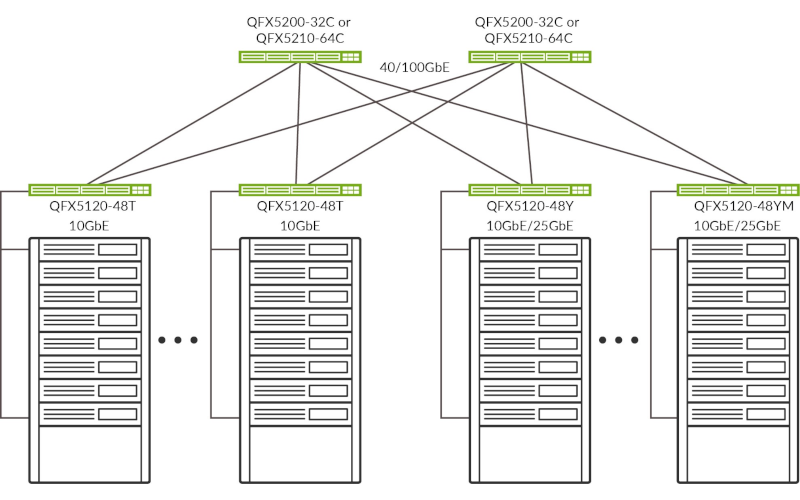
Figure 1: Edge-routed bridging at the leaf with QFX5200-32C/QFX5210-64C as spine switches
In Figure 2, the QFX5120-48YM leaf and Juniper Networks QFX10008 Switch spine are deployed as EVPN-VXLAN switches acting as centrally routed gateways or distributed edge routed gateways. If centrally routed bridging is used, the VXLAN tunnel encapsulation and decapsulation occur on the spine switches for inter-IRB (integrated routing and bridging) symmetric routing purposes. If edge routed bridging is used, the IP first hop gateways are distributed at the leaf-level QFX5120-48YM switches using Type 5 symmetric inter-IRB routing. When using a QFX10000-30CM MACsec line card installed in a spine QFX10008 Switch working with a leaf QFX5120-48YM switch, the leaf-to-spine architecture offers end-to-end MACsec AES-256 capabilities.
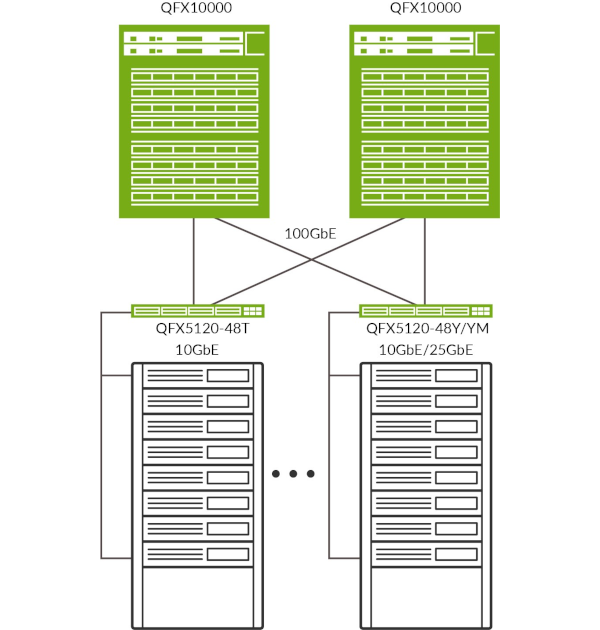
Figure 2: QFX5120-48T and QFX5120-48Y/48YM in a leaf-and-spine deployment
Data Center Spine
The QFX5120-32C, with 32 ports of 100GbE, can serve as the spine in small to medium-sized enterprise data centers. The QFX5120-32C can be deployed in a three-stage IP Clos with EVPN-VXLAN overlay to support as many as 1500 server access ports. The QFX5120-48Y/QFX5120-48YM and QFX5120-32C can also be used as a collapsed spine data center deployment, offering Ethernet segment identifier-link aggregation group (ESI-LAG) connectivity to the rest of the network infrastructure blocks.
All QFX5120 switches can operate in both cut-through and storeand-forward modes, delivering sustained wire-speed switching with sub-microsecond latency and low jitter for any packet size (including jumbo frames) in either mode. With features such as multichassis link aggregation (MC-LAG), the QFX5120 supports active/active server dual-homing and can use full bisectional bandwidth from server to switch.
Equipped with Junos OS, the QFX5120 supports the most advanced and robust routing capabilities in the industry, OSPF for both IPv4 and IPv6, as well as advanced routing capabilities such as IS-IS and BGP. With additional capabilities such as 64-way equalcost multipath (ECMP) and BGP add path, the QFX5120 is an ideal building block for deploying the most robust L3 underlay for SDN.
Campus Deployments
The QFX5120-48Y and QFX5120-48YM are ideal as campus distribution switches with 10GbE/25GbE downlinks and 40GbE/ 100GbE uplinks supporting technologies like MC-LAG and EVPN multihoming.
The QFX5120-32C is ideal as a campus core switch with 32 ports of 100GbE and support for technologies like campus fabric coredistribution.
The QFX5120-48T supports dual-speed 1GbE/10GbE, also making it a perfect fit for top-of-rack deployments in campus environments for server connectivity.
MC-LAG and EVPN Multihoming (Collapsed Core/Distribution)
A pair of interconnected QFX5120 switches can be deployed to provide EVPN multihoming (ESI-LAG) or multichassis link aggregation (MC-LAG) in a collapsed core/distribution configuration. This eliminates the need for Spanning Tree Protocol (STP) across the campus network by providing multihoming capabilities from the access to the distribution layer, while distribution to the core is an L3 IP fabric. ESI-LAG also supports horizontal scaling with more than two devices in the distribution layer and can extend EVPN to the core.
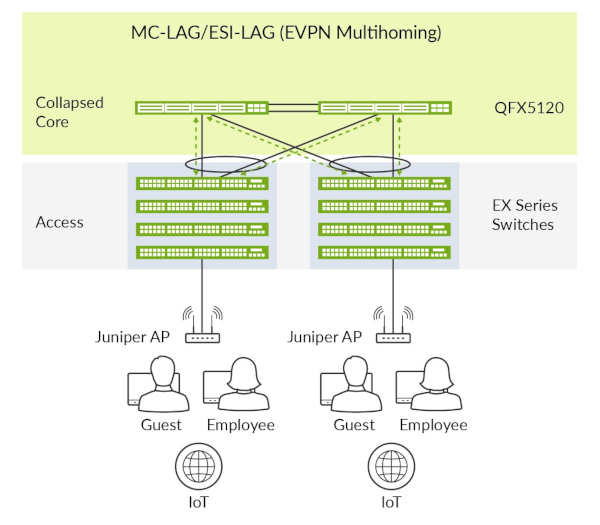
Figure 3: QFX5120 as a campus collapsed core/distribution switch with EVPN multihoming (ESI-LAG) and MC-LAG support.
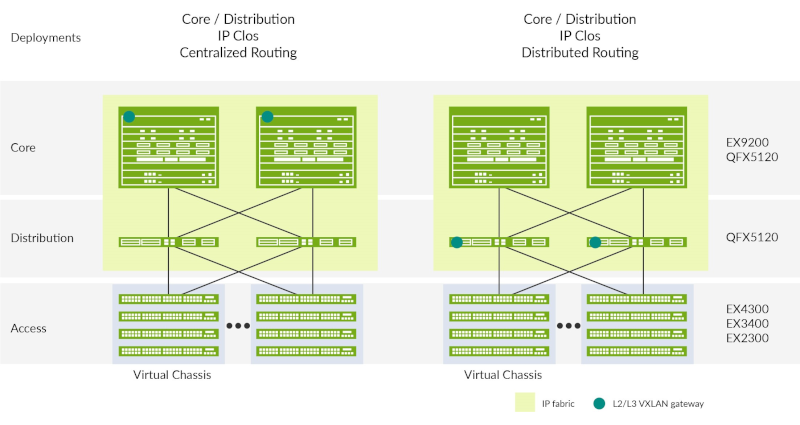
Figure 4: QFX5120 as a campus distribution switch with EVPN-VXLAN L2/L3 gateway support.
Campus Fabric Core-Distribution
A pair of interconnected QFX5120 switches can provide EVPN L2 and L3 VXLAN gateway support. This eliminates the need for STP across the campus network by providing a multihoming capability from the access to the distribution layer, while distribution to the core is an L3 IP fabric using EVPN technology. The IP fabric can also extend to connect multiple enterprise buildings, while VXLAN allows stretching L2 across buildings. An IP Clos network between the distribution and the core layers can exist in two modes, both of which are supported by the QFX5120:
- Centrally routed bridging overlay: An IRB interface placed at a central location in the fabric (in this case, a core device)
- Edge routed bridging overlay: An IRB interface placed at the edge of the fabric (in this case, a distribution device)
Features and Benefits:
- Automation: The QFX5120 supports a number of network automation and plug-and-play operational features, including ZTP and event scripts, automatic rollback, and Python scripting.
- Flexible forwarding table: The QFX5120 includes a unified forwarding table, which allows the hardware table to be carved into configurable partitions of L2 media access control (MAC), L3 host, and longest prefix match (LPM) tables. In a pure L2 environment, the QFX5120 supports 288,000 MAC addresses. In L3 mode, the table can support 208,000 host entries. In LPM mode, it can support 351,000 prefixes. Junos OS provides configurable options through a CLI that can optimize the QFX5120 for various deployment scenarios.
- Intelligent buffer management: The QFX5120 features a total of 32 MB of shared buffers. While 25% of the total buffer space is dedicated, the rest is shared among all ports and is user configurable. The intelligent buffer mechanism in the QFX5120 effectively absorbs traffic bursts while providing deterministic performance, significantly increasing performance over static allocation.
- MPLS: A broad set of MPLS features, including L3 VPN, IPv6 provider edge router (6PE), RSVP traffic engineering, and LDP allow standards-based network segmentation and virtualization, enabling the QFX5120 to be deployed as a low latency MPLS label-switching router (LSR).
- VXLAN overlays: The QFX5120 switch is capable of both L2 and L3 gateway services. Customers can deploy overlay networks to provide L2 adjacencies for applications over L3 fabrics. The overlay networks use VXLAN in the data plane and EVPN or Open vSwitch Database (OVSDB) for programming the overlays.
- MACsec and hop-by-hop encryption: The QFX5120-48YM supports IEEE 802.1AE MACsec AES-256, providing link-layer data confidentiality, data integrity, and data origin authentication. The MACsec feature enables the QFX5120-48YM to support 2 Tbps of near line-rate hardware-based traffic encryption on all 100GbE, 40GbE, 25GbE, 10GbE, and 1GbE ports. Defined by IEEE 802.1AE, MACsec provides secure, encrypted communication at the link layer that is capable of identifying and preventing threats from denial-of-service (DoS) and intrusion attacks, as well as man-in-the-middle, masquerading, passive wiretapping, and playback attacks launched from behind the firewall. When MACsec is deployed on switch ports, all traffic is encrypted on the wire, but traffic inside the switch is not. This allows the switch to apply network capabilities such as quality of service (QoS) and sFlow to each packet without compromising the security of packets on the wire.
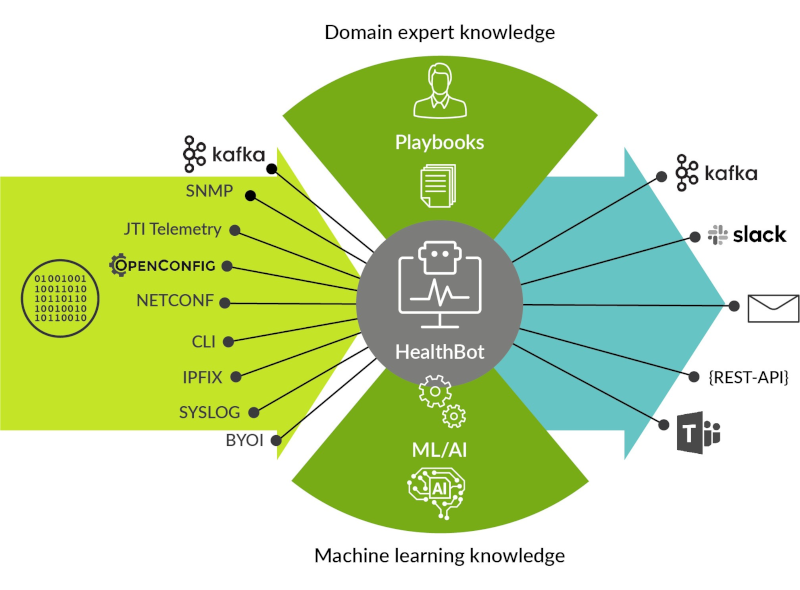
Juniper HealthBot overview
In addition, Ethernet-based WAN networks can use MACsec to provide link security over long haul connections. MACsec is transparent to Layer 3 and higher layer protocols and is not limited to IP traffic; it works with any type of wired or wireless traffic carried over Ethernet links.
- Virtual Chassis: The QFX5120 supports Juniper Networks unique Virtual Chassis technology, which enables up to four interconnected switches to operate as a single, logical device with a single IP address. This technology allows campus enterprises to eliminate STP and efficiently utilize network links.
Junos Telemetry Interface
The QFX5120 supports Junos telemetry interface (JTI), a modern telemetry streaming tool designed for performance monitoring in complex, dynamic data centers. Streaming data to a performance management system enables network administrators to measure trends in link and node utilization and troubleshoot such issues as network congestion in real time. JTI delivers the following features:
- Application visibility and performance management by provisioning sensors to collect and stream data and analyze application and workload flow paths through the network
- Capacity planning and optimization by proactively detecting hotspots and monitoring latency and microbursts
- Troubleshooting and root cause analysis via high-frequency monitoring and correlation of overlay and underlay networks
Monitoring and Analytics with Juniper HealthBot Software
Juniper HealthBot software delivers the following features and benefits for enhanced monitoring and analytics:
- Key performance indicator collection and visualization
- Anomaly detection
- Root cause analysis
- Automated remediation
- Multivendor support
- Customizable playbooks
- JTI telemetry











